Monogram 1/72 Space Shuttle Columbia | 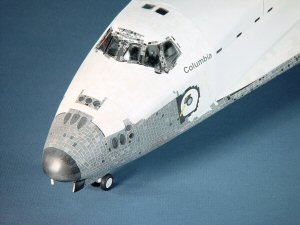 | Background 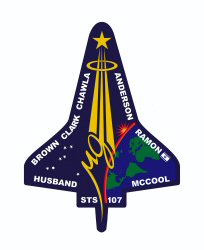 The world’s first successful reusable space vehicle was the United States’ Space Shuttle designed by Rockwell International. Under their contract, Rockwell built five vehicles: Enterprise, Columbia, Challenger, Discovery and Atlantis. Vehicle six, assembled from fleet spares, would become Endeavour and replace Challenger. The world’s first successful reusable space vehicle was the United States’ Space Shuttle designed by Rockwell International. Under their contract, Rockwell built five vehicles: Enterprise, Columbia, Challenger, Discovery and Atlantis. Vehicle six, assembled from fleet spares, would become Endeavour and replace Challenger.
Enterprise, named for the Star Trek Starship of the same name, was used to do the final testing of ‘dead-stick’ landing a vehicle this size which had been simulated extensively on computers and using surrogate aircraft. Mounted atop a modified Boeing 747, Enterprise was ‘dropped’ from altitude numerous times to prove the validity of all of the work accomplished to date. One of the distinguishing features of the Shuttle is its huge delta wing. One characteristic learned from flight test and many years of experience is that the delta wing is an efficient cruiser until you raise the nose. Once the nose comes up, whether in a turn or sudden pitch-up, the wing turns into an efficient speed brake. If you've ever watched an F-106 in the overhead pattern, he flys down the runway at 250+ knots and by the time he has pitched out 180 degrees into downwind (just a few seconds), he is already slow enough to safely extend his landing gear. The high-drag nature of that huge delta wing is one of the big pluses of the Shuttle. If you’ve watched some of the Shuttle-oriented movies like Space Camp or Space Cowboys, they both accurately depict that the nose of the shuttle needs to be kept up at a high (30-40 degree) angle during re-entry. In fact there are four larger thrusters in the nose for that very purpose. At that angle, the bottom of the shuttle doubles as a heat shield and a speed brake, slowing the Shuttle from about Mach 25 at the beginning of re-entry to above Mach 1 as it passes over the runway on its outbound approach leg. The final turn towards the runway brings the speed of the Shuttle down to approach speed and its ultimate 200 knot (240 MPH) touch-down speed. Columbia would be the first orbiter in space. With a crew of two seated in ejection seats, Columbia proved that the strap-on launch system, thermal tile protection and landing automation systems all worked as advertised. A new chapter of manned spaceflight was opened. Eventually the ejection seats were replaced with more crew positions and the orbiters were in the science business. The shuttle fleet can carry up to seven crewmembers aloft, though they had best not be claustrophobic! STS-107 was Columbia’s first flight after an extended overhaul to install the latest fleet improvements, including the new ‘glass’ cockpit (replacing the variety of gauges with multi-function CRTs). 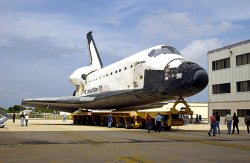 I remember having the television on with the video off while preparing for a flight – there was what appeared to be archived footage of the shuttle gliding down to the runway at Edwards. As the shuttle neared touchdown, the pilot elected to shoot a missed approach and started to climb out. After I picked up my fallen jaw, I turned up the audio to learn that what I was watching was the Soviet Buran space shuttle undergoing its own flight test regimen. The ingenious Soviet designers had installed a fuel cell inside the vehicle and it was feeding the four afterburning MiG-21 engines that were strapped to the rear of the Buran. Even though the Buran and its Ehnergia launch vehicle made one successful unmanned flight into space, the Soviets abandoned the project. Soyuz series remain the only manned vehicle program within the Russian space program and these are expendable capsules launched atop expendable launch vehicles. To their credit however, the Russians continue to fly while the US abandoned its family of expendable manned spacecraft and the Shuttle fleet is grounded. I remember having the television on with the video off while preparing for a flight – there was what appeared to be archived footage of the shuttle gliding down to the runway at Edwards. As the shuttle neared touchdown, the pilot elected to shoot a missed approach and started to climb out. After I picked up my fallen jaw, I turned up the audio to learn that what I was watching was the Soviet Buran space shuttle undergoing its own flight test regimen. The ingenious Soviet designers had installed a fuel cell inside the vehicle and it was feeding the four afterburning MiG-21 engines that were strapped to the rear of the Buran. Even though the Buran and its Ehnergia launch vehicle made one successful unmanned flight into space, the Soviets abandoned the project. Soyuz series remain the only manned vehicle program within the Russian space program and these are expendable capsules launched atop expendable launch vehicles. To their credit however, the Russians continue to fly while the US abandoned its family of expendable manned spacecraft and the Shuttle fleet is grounded.
With the loss of Challenger during the launch STS-51L, and more recently Columbia during the recovery of STS-107, we are reminded that the machines that we rely upon, whether to carry us across town, across the country, or even up into orbit, are man-made and will occasionally fail. While our society is quick to demand accountability, it is ultimately a choice that we make to use these machines to improve our lives and pray that in using these machines, we don’t do so in a manner that will become the subject of yet another warning sticker for future users. Let’s hope that we don’t lose the dream to reach for the stars in these days of limited budgets and world turmoil. Our future awaits us out there and we’ve lost enough momentum already! The Project 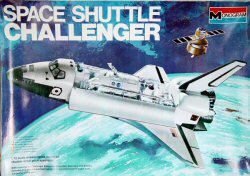 The motivation for this project came about for several reasons. First, I’ve wanted to tackle the huge 1/72 scale Monogram kit for some time (I know that ‘huge’ and 1/72 sound mutually exclusive, but the assembled model is 20 inches long, has a 13 inch wingspan and needs 10 inches of vertical clearance sitting on its landing gear). I’ve been dragging this kit around the country with me since I bought it new in 1979. Second, I wanted to honor the crew of STS-107, STS-51L and all of the men and women who put their lives on the line in the name of science and exploration. Finally, I’ve had a fundamental problem with simply painting the underside of the Shuttle flat black to represent all of those protective tiles. Cutting Edge recently solved this problem with a set of decals (three huge 8.5”x11” sheets) to represent the various “black” and “white” tiles that protect that otherwise ordinary aluminum structure. A project was born. The motivation for this project came about for several reasons. First, I’ve wanted to tackle the huge 1/72 scale Monogram kit for some time (I know that ‘huge’ and 1/72 sound mutually exclusive, but the assembled model is 20 inches long, has a 13 inch wingspan and needs 10 inches of vertical clearance sitting on its landing gear). I’ve been dragging this kit around the country with me since I bought it new in 1979. Second, I wanted to honor the crew of STS-107, STS-51L and all of the men and women who put their lives on the line in the name of science and exploration. Finally, I’ve had a fundamental problem with simply painting the underside of the Shuttle flat black to represent all of those protective tiles. Cutting Edge recently solved this problem with a set of decals (three huge 8.5”x11” sheets) to represent the various “black” and “white” tiles that protect that otherwise ordinary aluminum structure. A project was born.
Assembly 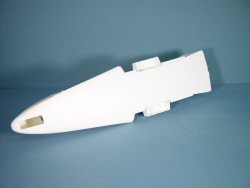 Did I mention that I’ve drug this kit around the country over the last 23+ years? Between sitting on the shelf, sitting in storage, and spending quality time in moving vans, it was a small wonder that the kit wasn’t warped beyond recognition. However, dry-fitting the fuselage halves did reveal that some warpage had indeed worked its way into the model. After cleaning the edges, I cemented the two fuselage halves together using Tamiya liquid cement and working several inches at a time. Once the fuselage was together and dry, the strength of the bond was proven when I dropped the bloody thing on the floor. I used Mr. Surfacer 500 applied to the seams to fill the gaps, with care given to preserve the details of the forward-firing thrusters ahead of the windscreen. A few applications of Mr. Surfacer followed by a session at the kitchen sink to wet-sand the seams smooth rendered a smooth join. Did I mention that I’ve drug this kit around the country over the last 23+ years? Between sitting on the shelf, sitting in storage, and spending quality time in moving vans, it was a small wonder that the kit wasn’t warped beyond recognition. However, dry-fitting the fuselage halves did reveal that some warpage had indeed worked its way into the model. After cleaning the edges, I cemented the two fuselage halves together using Tamiya liquid cement and working several inches at a time. Once the fuselage was together and dry, the strength of the bond was proven when I dropped the bloody thing on the floor. I used Mr. Surfacer 500 applied to the seams to fill the gaps, with care given to preserve the details of the forward-firing thrusters ahead of the windscreen. A few applications of Mr. Surfacer followed by a session at the kitchen sink to wet-sand the seams smooth rendered a smooth join.
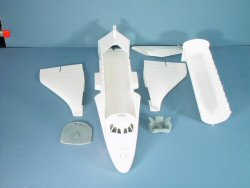 The beauty of this project is that you can assemble the main structures and complete your gap filling without endangering the interior, landing gear, etc. Next up were the wings and tail. I thought briefly about drooping the elevons for this project and decided that was a level of masochism I wasn’t ready for (yet). I did remove the tip of the tail and replaced it with the Cutting Edge fin-tip camera pod that was used to photograph the unique thermal phenomenon that would engulf the vehicle during re-entry. Columbia was the only Shuttle to receive this camera to date. While I elected to keep the tail off of the Shuttle until the end of the project, I installed the wings with Tamiya liquid cement and followed up with another gap-filling treatment of Mr. Surfacer 500. With the major structure together and cleaned-up, it was time to get the rest of the vehicle together. The beauty of this project is that you can assemble the main structures and complete your gap filling without endangering the interior, landing gear, etc. Next up were the wings and tail. I thought briefly about drooping the elevons for this project and decided that was a level of masochism I wasn’t ready for (yet). I did remove the tip of the tail and replaced it with the Cutting Edge fin-tip camera pod that was used to photograph the unique thermal phenomenon that would engulf the vehicle during re-entry. Columbia was the only Shuttle to receive this camera to date. While I elected to keep the tail off of the Shuttle until the end of the project, I installed the wings with Tamiya liquid cement and followed up with another gap-filling treatment of Mr. Surfacer 500. With the major structure together and cleaned-up, it was time to get the rest of the vehicle together.
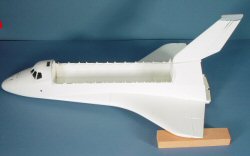 First up was the cockpit and fuselage interior that I sprayed with a base coat of Tamiya Light Gray. Using my handy copy of Squadron/Signal’s Shuttle Walkaround, I painted the remainder of the cockpit to replicate the colors and details that would be visible through the windscreen. I didn’t waste time with detailing the instrument panel beyond a dry-brushing as none of this would be readily visible. I also installed the rear cockpit overhead window at this point. Upon completion, the cockpit tub snaps into place in the nose section. First up was the cockpit and fuselage interior that I sprayed with a base coat of Tamiya Light Gray. Using my handy copy of Squadron/Signal’s Shuttle Walkaround, I painted the remainder of the cockpit to replicate the colors and details that would be visible through the windscreen. I didn’t waste time with detailing the instrument panel beyond a dry-brushing as none of this would be readily visible. I also installed the rear cockpit overhead window at this point. Upon completion, the cockpit tub snaps into place in the nose section.
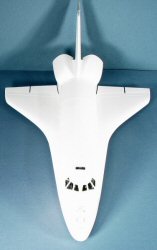 Before installing the interior of the cargo bay, you must install the inboard walls of the main wheel wells. I chose not to install the landing gear until the end and this turned out to be the best solution. With the well walls in place, I assembled the interior of the cargo bay with the forward and rear bulkheads. After dry-fitting the subassembly into the fuselage (no problems there), you need to install the cargo bay doors in order to trap the doors between the fuselage and cargo bay hinge points. With everything together, I cemented the cargo bay in place. I had decided to display the vehicle as it would appear on its landing gear, therefore the cargo bay doors would be cemented shut and no time spent inside the cargo bay. I cemented an Evergreen plastic strip inside one side of the cargo bay doors to provide a solid joint when the doors are closed. With that dry, I cemented the doors shut and filled any gaps with Mr. Surfacer 500. I also removed the plastic tabs used to hinge the cargo bay doors, trimming them flush with the fuselage sides. Now the model was looking more like a replica and less like a toy. Before installing the interior of the cargo bay, you must install the inboard walls of the main wheel wells. I chose not to install the landing gear until the end and this turned out to be the best solution. With the well walls in place, I assembled the interior of the cargo bay with the forward and rear bulkheads. After dry-fitting the subassembly into the fuselage (no problems there), you need to install the cargo bay doors in order to trap the doors between the fuselage and cargo bay hinge points. With everything together, I cemented the cargo bay in place. I had decided to display the vehicle as it would appear on its landing gear, therefore the cargo bay doors would be cemented shut and no time spent inside the cargo bay. I cemented an Evergreen plastic strip inside one side of the cargo bay doors to provide a solid joint when the doors are closed. With that dry, I cemented the doors shut and filled any gaps with Mr. Surfacer 500. I also removed the plastic tabs used to hinge the cargo bay doors, trimming them flush with the fuselage sides. Now the model was looking more like a replica and less like a toy.
I completed this round of assembly by adding the OMS engine pods to the flat sections left and right of the vertical stab mount and filling any gaps with more Mr. Surfacer 500. One last trip to the sink to wet sand the now huge plastic mass and remove any remaining scratches. I installed the windscreens with watch crystal cement, which provides a strong bond without harming the clear surface (available at most model railroad supply shops). Painting It was now time to see how well the prep work had paid off. I masked off the windows with Tamiya masking tape cut to shape. Two key points to make here: I did not install the rear fuselage plate that mounts the three main engines and two OMS engines, nor have I installed the nose gear well. With the rear plate off, I had a solid place to put my hand and maneuver the model while painting. At the end of each painting session, I used a short bungee cord to suspend the shuttle from the ceiling and the shuttle would hand nicely from the bungee hook through the open hole where the nose gear well will install later. 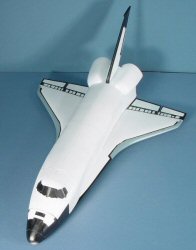 The chaps at the local hobby establishment convinced me to try out the line of Tamiya Spray Lacquers. Since the wife was out of town for the day, I thought I’d give it a whirl. First on was a primer gray to blend the resin tail to the white plastic as well as the gray Mr. Surfacer with the surrounding hull. After a good coat of gray, I was surprised to see just how fast the paint cured! After a few hours (to be on the safe side), I applied the first Black Magic masks from Cutting Edge for the 1/72 Space Shuttle set, these to mask off the gray wing leading edges. With these in place, I sprayed on two coats of gloss white. Once again the paint was dry to the touch within minutes, but it remained a bit tacky for several hours. Since I had to start masking the paint, I’d wait until the next day to move on. The chaps at the local hobby establishment convinced me to try out the line of Tamiya Spray Lacquers. Since the wife was out of town for the day, I thought I’d give it a whirl. First on was a primer gray to blend the resin tail to the white plastic as well as the gray Mr. Surfacer with the surrounding hull. After a good coat of gray, I was surprised to see just how fast the paint cured! After a few hours (to be on the safe side), I applied the first Black Magic masks from Cutting Edge for the 1/72 Space Shuttle set, these to mask off the gray wing leading edges. With these in place, I sprayed on two coats of gloss white. Once again the paint was dry to the touch within minutes, but it remained a bit tacky for several hours. Since I had to start masking the paint, I’d wait until the next day to move on.
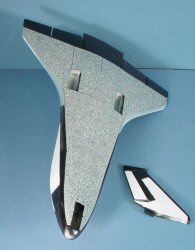 With the paint safely dry, I applied the appropriate Black Magic masks from Cutting Edge set. This set includes a number of options to replicate the variations in tile patterns that the shuttles displayed over their operational lives. One excellent example is the several tile patterns that were applied to Columbia’s vertical stabilizer before and after installation of the tip camera. With the paint safely dry, I applied the appropriate Black Magic masks from Cutting Edge set. This set includes a number of options to replicate the variations in tile patterns that the shuttles displayed over their operational lives. One excellent example is the several tile patterns that were applied to Columbia’s vertical stabilizer before and after installation of the tip camera.
While the Cutting Edge masks were not cut to fit the Monogram model (they were evidently scaled up from a 1/144 kit) they significantly cut down the time and complexity of masking off the white areas to be preserved around the wing trailing edges, tail and around the nose. Unfortunately I received a spousal veto on using the black lacquer, so this round went to Tamiya acrylic gloss black. This one I left to dry for another day. 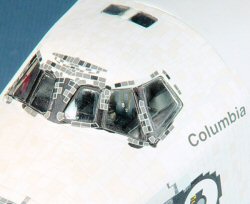 The following day I removed all of the masking and examined the results. Very not bad indeed! Now it was time to apply three sheets of decal tiles. I used a smaller cookie pan to soak the decals. While it was only a fraction of an inch deep, it was large enough to submerge the largest decal in the set without bending, folding or mutilation. The first two decals were the two largest, representing the majority of the underside of the shuttle. I thought I’d make matters easier by cutting the huge decals into three parts, oriented around one of the main landing gear doors. Since the decal went over the gear well as if the gear doors were closed, I put the main gear doors in place before applying the decals. This would turn out to be advantageous later. The following day I removed all of the masking and examined the results. Very not bad indeed! Now it was time to apply three sheets of decal tiles. I used a smaller cookie pan to soak the decals. While it was only a fraction of an inch deep, it was large enough to submerge the largest decal in the set without bending, folding or mutilation. The first two decals were the two largest, representing the majority of the underside of the shuttle. I thought I’d make matters easier by cutting the huge decals into three parts, oriented around one of the main landing gear doors. Since the decal went over the gear well as if the gear doors were closed, I put the main gear doors in place before applying the decals. This would turn out to be advantageous later.
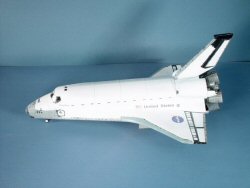 I installed the three sections of the left wing decal per the instructions and oriented the outlines for the gear door on the decal onto the corresponding part of the model. With everything in place and smooth, I applied a coat of Solvaset and set the model aside to see what happens. After an hour, the decal had settled onto the surface nicely, but the three sections of decals had shrunk slightly, leaving a slight gap. This was overcome with a fine paint brush and a little Tamiya Light Gray. The gap was gone. I installed the three sections of the left wing decal per the instructions and oriented the outlines for the gear door on the decal onto the corresponding part of the model. With everything in place and smooth, I applied a coat of Solvaset and set the model aside to see what happens. After an hour, the decal had settled onto the surface nicely, but the three sections of decals had shrunk slightly, leaving a slight gap. This was overcome with a fine paint brush and a little Tamiya Light Gray. The gap was gone.
I decided to apply the right wing decal intact to see how that worked. Once again, there were absolutely no problems with working the decal into its final position and responded beautifully with Solvaset. After another hour of drying time, I spotted a few bubbles under the decals, but a pin puncture and a spot of Solvaset eliminated those problems very quickly. 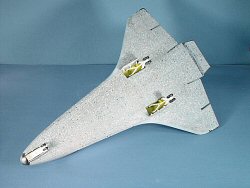 I applied the remainder of the decals per the instructions and discovered that these tiles, like the Black Magic masks, were evidently scaled up from another kit. The shape of the Monogram Shuttle is slightly different and this becomes evident once all of the major decal sections are applied. This was primarily up around the areas where the wing chines blend into the fuselage and the area around the beavertail. In these areas were gaps between decals allowing the plain black undersurface to shine through. Fortunately, the Cutting Edge folks have provided enough spares, including decals for the main gear doors that I could use now to ‘patch’ the gaps. It is amazing that once the decals are all in place and snuggled down with Solvaset, you can’s spot any of the problem areas. I applied the remainder of the decals per the instructions and discovered that these tiles, like the Black Magic masks, were evidently scaled up from another kit. The shape of the Monogram Shuttle is slightly different and this becomes evident once all of the major decal sections are applied. This was primarily up around the areas where the wing chines blend into the fuselage and the area around the beavertail. In these areas were gaps between decals allowing the plain black undersurface to shine through. Fortunately, the Cutting Edge folks have provided enough spares, including decals for the main gear doors that I could use now to ‘patch’ the gaps. It is amazing that once the decals are all in place and snuggled down with Solvaset, you can’s spot any of the problem areas.
The one thing that is evident after all of the tile decals are in place is just how light the colors are for all of the tiles. I read an interesting idea out on the internet and applied a mixture of Tamiya Smoke (clear brown) with Tamiya Flat Base and Isopropyl Alcohol (to thin the mixture for airbrushing) to the ‘dark’ tiles to darken them further. This is where you can darken them to your preferences as I only applied two coats. Decals 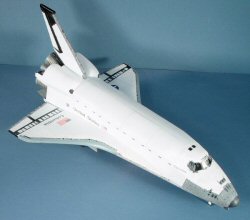 I know, I just covered the model with decals, but they are still only background effect. Now it is time to give this model identity. Of course the kit decals have long-since dried up and shriveled. This is where another Cutting Edge product comes to the rescue – Space Shuttle – All Orbiter Variants. They provide the markings for all six vehicles as they appeared virtually any time in their careers. I dropped over to the Kennedy Space Center website and found the photos of Columbia prior to mating with the external tank and booster stacks. I found that NASA had finally replaced the USA logo that had been on her wing through most of her career with the NASA meatball logo. Noting all of the details, I selected and applied the appropriate markings. Once again, these decals went down with no problems, even over the tile decals. I know, I just covered the model with decals, but they are still only background effect. Now it is time to give this model identity. Of course the kit decals have long-since dried up and shriveled. This is where another Cutting Edge product comes to the rescue – Space Shuttle – All Orbiter Variants. They provide the markings for all six vehicles as they appeared virtually any time in their careers. I dropped over to the Kennedy Space Center website and found the photos of Columbia prior to mating with the external tank and booster stacks. I found that NASA had finally replaced the USA logo that had been on her wing through most of her career with the NASA meatball logo. Noting all of the details, I selected and applied the appropriate markings. Once again, these decals went down with no problems, even over the tile decals.
Final Steps 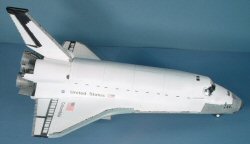 It was time for final assembly. The main landing gear, nose gear and nose gear well, and rear engine plate were installed. The Shuttle was now standing on its own. The next step was to paint and install the Cutting Edge main and OMS engine bells. These provide a more accurate shape and there is nice detail on the main bells. Before I finally glued the vertical stabilizer into place, I studied a few of the NASA photos to fabricate the braking parachute housing that was installed at the base of the tail. I’m not certain if Columbia received the braking chute capability before it went in for its updates, but it was definitively there during STS-107. The housing was fabricated from strips of Evergreen plastic that were laminated together, filed into shape, painted and installed. It was time for final assembly. The main landing gear, nose gear and nose gear well, and rear engine plate were installed. The Shuttle was now standing on its own. The next step was to paint and install the Cutting Edge main and OMS engine bells. These provide a more accurate shape and there is nice detail on the main bells. Before I finally glued the vertical stabilizer into place, I studied a few of the NASA photos to fabricate the braking parachute housing that was installed at the base of the tail. I’m not certain if Columbia received the braking chute capability before it went in for its updates, but it was definitively there during STS-107. The housing was fabricated from strips of Evergreen plastic that were laminated together, filed into shape, painted and installed.
Conclusions 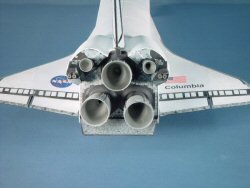 The project took a few weeks to complete. While assembly and painting didn’t take much time, gap filling and decaling were the major efforts – not difficult, just time consuming. I’d have to say that roughly one third of this model is covered in decals and the majority of them are smaller pieces that require patience in order to get the desired results. The project took a few weeks to complete. While assembly and painting didn’t take much time, gap filling and decaling were the major efforts – not difficult, just time consuming. I’d have to say that roughly one third of this model is covered in decals and the majority of them are smaller pieces that require patience in order to get the desired results.
Will I do this project again? Not unless Cutting Edge keeps these decals in production (they’re limited editions). I can’t imagine doing another Space Shuttle without them! The project was fun and I would certainly like to do this project again. In the meantime, I have a tribute on my shelf to say "Farewell Columbia - our prayers are with the gallant men and women of your crew." Resources -
1/72 Space Shuttle (this kit has been reissued many times with and without the ET and SRBs) -
Space Shuttle Tile Masks CEBM72165 -
Space Shuttle - All Orbiter Variants CED72012 -
Space Shuttle Orbiter Tile Patterns CED72083 -
Shuttle Orbiter Nozzles CELO72001 -
Columbia Fin Camera CELO72002 -
Walk Around Space Shuttle, Mike Savage, Squadron/Signal Publications, ISBN 0-89747-406-6, Copyright 1999 Online References: | 








|

 The world’s first successful reusable space vehicle was the United States’ Space Shuttle designed by Rockwell International. Under their contract, Rockwell built five vehicles: Enterprise, Columbia, Challenger, Discovery and Atlantis. Vehicle six, assembled from fleet spares, would become Endeavour and replace Challenger.
The world’s first successful reusable space vehicle was the United States’ Space Shuttle designed by Rockwell International. Under their contract, Rockwell built five vehicles: Enterprise, Columbia, Challenger, Discovery and Atlantis. Vehicle six, assembled from fleet spares, would become Endeavour and replace Challenger. I remember having the television on with the video off while preparing for a flight – there was what appeared to be archived footage of the shuttle gliding down to the runway at Edwards. As the shuttle neared touchdown, the pilot elected to shoot a missed approach and started to climb out. After I picked up my fallen jaw, I turned up the audio to learn that what I was watching was the Soviet Buran space shuttle undergoing its own flight test regimen. The ingenious Soviet designers had installed a fuel cell inside the vehicle and it was feeding the four afterburning MiG-21 engines that were strapped to the rear of the Buran. Even though the Buran and its Ehnergia launch vehicle made one successful unmanned flight into space, the Soviets abandoned the project. Soyuz series remain the only manned vehicle program within the Russian space program and these are expendable capsules launched atop expendable launch vehicles. To their credit however, the Russians continue to fly while the US abandoned its family of expendable manned spacecraft and the Shuttle fleet is grounded.
I remember having the television on with the video off while preparing for a flight – there was what appeared to be archived footage of the shuttle gliding down to the runway at Edwards. As the shuttle neared touchdown, the pilot elected to shoot a missed approach and started to climb out. After I picked up my fallen jaw, I turned up the audio to learn that what I was watching was the Soviet Buran space shuttle undergoing its own flight test regimen. The ingenious Soviet designers had installed a fuel cell inside the vehicle and it was feeding the four afterburning MiG-21 engines that were strapped to the rear of the Buran. Even though the Buran and its Ehnergia launch vehicle made one successful unmanned flight into space, the Soviets abandoned the project. Soyuz series remain the only manned vehicle program within the Russian space program and these are expendable capsules launched atop expendable launch vehicles. To their credit however, the Russians continue to fly while the US abandoned its family of expendable manned spacecraft and the Shuttle fleet is grounded. The motivation for this project came about for several reasons. First, I’ve wanted to tackle the huge 1/72 scale Monogram kit for some time (I know that ‘huge’ and 1/72 sound mutually exclusive, but the assembled model is 20 inches long, has a 13 inch wingspan and needs 10 inches of vertical clearance sitting on its landing gear). I’ve been dragging this kit around the country with me since I bought it new in 1979. Second, I wanted to honor the crew of STS-107, STS-51L and all of the men and women who put their lives on the line in the name of science and exploration. Finally, I’ve had a fundamental problem with simply painting the underside of the Shuttle flat black to represent all of those protective tiles. Cutting Edge recently solved this problem with a set of decals (three huge 8.5”x11” sheets) to represent the various “black” and “white” tiles that protect that otherwise ordinary aluminum structure. A project was born.
The motivation for this project came about for several reasons. First, I’ve wanted to tackle the huge 1/72 scale Monogram kit for some time (I know that ‘huge’ and 1/72 sound mutually exclusive, but the assembled model is 20 inches long, has a 13 inch wingspan and needs 10 inches of vertical clearance sitting on its landing gear). I’ve been dragging this kit around the country with me since I bought it new in 1979. Second, I wanted to honor the crew of STS-107, STS-51L and all of the men and women who put their lives on the line in the name of science and exploration. Finally, I’ve had a fundamental problem with simply painting the underside of the Shuttle flat black to represent all of those protective tiles. Cutting Edge recently solved this problem with a set of decals (three huge 8.5”x11” sheets) to represent the various “black” and “white” tiles that protect that otherwise ordinary aluminum structure. A project was born. Did I mention that I’ve drug this kit around the country over the last 23+ years? Between sitting on the shelf, sitting in storage, and spending quality time in moving vans, it was a small wonder that the kit wasn’t warped beyond recognition. However, dry-fitting the fuselage halves did reveal that some warpage had indeed worked its way into the model. After cleaning the edges, I cemented the two fuselage halves together using Tamiya liquid cement and working several inches at a time. Once the fuselage was together and dry, the strength of the bond was proven when I dropped the bloody thing on the floor. I used Mr. Surfacer 500 applied to the seams to fill the gaps, with care given to preserve the details of the forward-firing thrusters ahead of the windscreen. A few applications of Mr. Surfacer followed by a session at the kitchen sink to wet-sand the seams smooth rendered a smooth join.
Did I mention that I’ve drug this kit around the country over the last 23+ years? Between sitting on the shelf, sitting in storage, and spending quality time in moving vans, it was a small wonder that the kit wasn’t warped beyond recognition. However, dry-fitting the fuselage halves did reveal that some warpage had indeed worked its way into the model. After cleaning the edges, I cemented the two fuselage halves together using Tamiya liquid cement and working several inches at a time. Once the fuselage was together and dry, the strength of the bond was proven when I dropped the bloody thing on the floor. I used Mr. Surfacer 500 applied to the seams to fill the gaps, with care given to preserve the details of the forward-firing thrusters ahead of the windscreen. A few applications of Mr. Surfacer followed by a session at the kitchen sink to wet-sand the seams smooth rendered a smooth join. The beauty of this project is that you can assemble the main structures and complete your gap filling without endangering the interior, landing gear, etc. Next up were the wings and tail. I thought briefly about drooping the elevons for this project and decided that was a level of masochism I wasn’t ready for (yet). I did remove the tip of the tail and replaced it with the Cutting Edge fin-tip camera pod that was used to photograph the unique thermal phenomenon that would engulf the vehicle during re-entry. Columbia was the only Shuttle to receive this camera to date. While I elected to keep the tail off of the Shuttle until the end of the project, I installed the wings with Tamiya liquid cement and followed up with another gap-filling treatment of Mr. Surfacer 500. With the major structure together and cleaned-up, it was time to get the rest of the vehicle together.
The beauty of this project is that you can assemble the main structures and complete your gap filling without endangering the interior, landing gear, etc. Next up were the wings and tail. I thought briefly about drooping the elevons for this project and decided that was a level of masochism I wasn’t ready for (yet). I did remove the tip of the tail and replaced it with the Cutting Edge fin-tip camera pod that was used to photograph the unique thermal phenomenon that would engulf the vehicle during re-entry. Columbia was the only Shuttle to receive this camera to date. While I elected to keep the tail off of the Shuttle until the end of the project, I installed the wings with Tamiya liquid cement and followed up with another gap-filling treatment of Mr. Surfacer 500. With the major structure together and cleaned-up, it was time to get the rest of the vehicle together. First up was the cockpit and fuselage interior that I sprayed with a base coat of Tamiya Light Gray. Using my handy copy of Squadron/Signal’s Shuttle Walkaround, I painted the remainder of the cockpit to replicate the colors and details that would be visible through the windscreen. I didn’t waste time with detailing the instrument panel beyond a dry-brushing as none of this would be readily visible. I also installed the rear cockpit overhead window at this point. Upon completion, the cockpit tub snaps into place in the nose section.
First up was the cockpit and fuselage interior that I sprayed with a base coat of Tamiya Light Gray. Using my handy copy of Squadron/Signal’s Shuttle Walkaround, I painted the remainder of the cockpit to replicate the colors and details that would be visible through the windscreen. I didn’t waste time with detailing the instrument panel beyond a dry-brushing as none of this would be readily visible. I also installed the rear cockpit overhead window at this point. Upon completion, the cockpit tub snaps into place in the nose section. Before installing the interior of the cargo bay, you must install the inboard walls of the main wheel wells. I chose not to install the landing gear until the end and this turned out to be the best solution. With the well walls in place, I assembled the interior of the cargo bay with the forward and rear bulkheads. After dry-fitting the subassembly into the fuselage (no problems there), you need to install the cargo bay doors in order to trap the doors between the fuselage and cargo bay hinge points. With everything together, I cemented the cargo bay in place. I had decided to display the vehicle as it would appear on its landing gear, therefore the cargo bay doors would be cemented shut and no time spent inside the cargo bay. I cemented an Evergreen plastic strip inside one side of the cargo bay doors to provide a solid joint when the doors are closed. With that dry, I cemented the doors shut and filled any gaps with Mr. Surfacer 500. I also removed the plastic tabs used to hinge the cargo bay doors, trimming them flush with the fuselage sides. Now the model was looking more like a replica and less like a toy.
Before installing the interior of the cargo bay, you must install the inboard walls of the main wheel wells. I chose not to install the landing gear until the end and this turned out to be the best solution. With the well walls in place, I assembled the interior of the cargo bay with the forward and rear bulkheads. After dry-fitting the subassembly into the fuselage (no problems there), you need to install the cargo bay doors in order to trap the doors between the fuselage and cargo bay hinge points. With everything together, I cemented the cargo bay in place. I had decided to display the vehicle as it would appear on its landing gear, therefore the cargo bay doors would be cemented shut and no time spent inside the cargo bay. I cemented an Evergreen plastic strip inside one side of the cargo bay doors to provide a solid joint when the doors are closed. With that dry, I cemented the doors shut and filled any gaps with Mr. Surfacer 500. I also removed the plastic tabs used to hinge the cargo bay doors, trimming them flush with the fuselage sides. Now the model was looking more like a replica and less like a toy. The chaps at the local hobby establishment convinced me to try out the line of Tamiya Spray Lacquers. Since the wife was out of town for the day, I thought I’d give it a whirl. First on was a primer gray to blend the resin tail to the white plastic as well as the gray Mr. Surfacer with the surrounding hull. After a good coat of gray, I was surprised to see just how fast the paint cured! After a few hours (to be on the safe side), I applied the first Black Magic masks from Cutting Edge for the 1/72 Space Shuttle set, these to mask off the gray wing leading edges. With these in place, I sprayed on two coats of gloss white. Once again the paint was dry to the touch within minutes, but it remained a bit tacky for several hours. Since I had to start masking the paint, I’d wait until the next day to move on.
The chaps at the local hobby establishment convinced me to try out the line of Tamiya Spray Lacquers. Since the wife was out of town for the day, I thought I’d give it a whirl. First on was a primer gray to blend the resin tail to the white plastic as well as the gray Mr. Surfacer with the surrounding hull. After a good coat of gray, I was surprised to see just how fast the paint cured! After a few hours (to be on the safe side), I applied the first Black Magic masks from Cutting Edge for the 1/72 Space Shuttle set, these to mask off the gray wing leading edges. With these in place, I sprayed on two coats of gloss white. Once again the paint was dry to the touch within minutes, but it remained a bit tacky for several hours. Since I had to start masking the paint, I’d wait until the next day to move on. With the paint safely dry, I applied the appropriate Black Magic masks from Cutting Edge set. This set includes a number of options to replicate the variations in tile patterns that the shuttles displayed over their operational lives. One excellent example is the several tile patterns that were applied to Columbia’s vertical stabilizer before and after installation of the tip camera.
With the paint safely dry, I applied the appropriate Black Magic masks from Cutting Edge set. This set includes a number of options to replicate the variations in tile patterns that the shuttles displayed over their operational lives. One excellent example is the several tile patterns that were applied to Columbia’s vertical stabilizer before and after installation of the tip camera.  The following day I removed all of the masking and examined the results. Very not bad indeed! Now it was time to apply three sheets of decal tiles. I used a smaller cookie pan to soak the decals. While it was only a fraction of an inch deep, it was large enough to submerge the largest decal in the set without bending, folding or mutilation. The first two decals were the two largest, representing the majority of the underside of the shuttle. I thought I’d make matters easier by cutting the huge decals into three parts, oriented around one of the main landing gear doors. Since the decal went over the gear well as if the gear doors were closed, I put the main gear doors in place before applying the decals. This would turn out to be advantageous later.
The following day I removed all of the masking and examined the results. Very not bad indeed! Now it was time to apply three sheets of decal tiles. I used a smaller cookie pan to soak the decals. While it was only a fraction of an inch deep, it was large enough to submerge the largest decal in the set without bending, folding or mutilation. The first two decals were the two largest, representing the majority of the underside of the shuttle. I thought I’d make matters easier by cutting the huge decals into three parts, oriented around one of the main landing gear doors. Since the decal went over the gear well as if the gear doors were closed, I put the main gear doors in place before applying the decals. This would turn out to be advantageous later. I installed the three sections of the left wing decal per the instructions and oriented the outlines for the gear door on the decal onto the corresponding part of the model. With everything in place and smooth, I applied a coat of Solvaset and set the model aside to see what happens. After an hour, the decal had settled onto the surface nicely, but the three sections of decals had shrunk slightly, leaving a slight gap. This was overcome with a fine paint brush and a little Tamiya Light Gray. The gap was gone.
I installed the three sections of the left wing decal per the instructions and oriented the outlines for the gear door on the decal onto the corresponding part of the model. With everything in place and smooth, I applied a coat of Solvaset and set the model aside to see what happens. After an hour, the decal had settled onto the surface nicely, but the three sections of decals had shrunk slightly, leaving a slight gap. This was overcome with a fine paint brush and a little Tamiya Light Gray. The gap was gone. I applied the remainder of the decals per the instructions and discovered that these tiles, like the Black Magic masks, were evidently scaled up from another kit. The shape of the Monogram Shuttle is slightly different and this becomes evident once all of the major decal sections are applied. This was primarily up around the areas where the wing chines blend into the fuselage and the area around the beavertail. In these areas were gaps between decals allowing the plain black undersurface to shine through. Fortunately, the Cutting Edge folks have provided enough spares, including decals for the main gear doors that I could use now to ‘patch’ the gaps. It is amazing that once the decals are all in place and snuggled down with Solvaset, you can’s spot any of the problem areas.
I applied the remainder of the decals per the instructions and discovered that these tiles, like the Black Magic masks, were evidently scaled up from another kit. The shape of the Monogram Shuttle is slightly different and this becomes evident once all of the major decal sections are applied. This was primarily up around the areas where the wing chines blend into the fuselage and the area around the beavertail. In these areas were gaps between decals allowing the plain black undersurface to shine through. Fortunately, the Cutting Edge folks have provided enough spares, including decals for the main gear doors that I could use now to ‘patch’ the gaps. It is amazing that once the decals are all in place and snuggled down with Solvaset, you can’s spot any of the problem areas.  I know, I just covered the model with decals, but they are still only background effect. Now it is time to give this model identity. Of course the kit decals have long-since dried up and shriveled. This is where another Cutting Edge product comes to the rescue – Space Shuttle – All Orbiter Variants. They provide the markings for all six vehicles as they appeared virtually any time in their careers. I dropped over to the Kennedy Space Center website and found the photos of Columbia prior to mating with the external tank and booster stacks. I found that NASA had finally replaced the USA logo that had been on her wing through most of her career with the NASA meatball logo. Noting all of the details, I selected and applied the appropriate markings. Once again, these decals went down with no problems, even over the tile decals.
I know, I just covered the model with decals, but they are still only background effect. Now it is time to give this model identity. Of course the kit decals have long-since dried up and shriveled. This is where another Cutting Edge product comes to the rescue – Space Shuttle – All Orbiter Variants. They provide the markings for all six vehicles as they appeared virtually any time in their careers. I dropped over to the Kennedy Space Center website and found the photos of Columbia prior to mating with the external tank and booster stacks. I found that NASA had finally replaced the USA logo that had been on her wing through most of her career with the NASA meatball logo. Noting all of the details, I selected and applied the appropriate markings. Once again, these decals went down with no problems, even over the tile decals. It was time for final assembly. The main landing gear, nose gear and nose gear well, and rear engine plate were installed. The Shuttle was now standing on its own. The next step was to paint and install the Cutting Edge main and OMS engine bells. These provide a more accurate shape and there is nice detail on the main bells. Before I finally glued the vertical stabilizer into place, I studied a few of the NASA photos to fabricate the braking parachute housing that was installed at the base of the tail. I’m not certain if Columbia received the braking chute capability before it went in for its updates, but it was definitively there during STS-107. The housing was fabricated from strips of Evergreen plastic that were laminated together, filed into shape, painted and installed.
It was time for final assembly. The main landing gear, nose gear and nose gear well, and rear engine plate were installed. The Shuttle was now standing on its own. The next step was to paint and install the Cutting Edge main and OMS engine bells. These provide a more accurate shape and there is nice detail on the main bells. Before I finally glued the vertical stabilizer into place, I studied a few of the NASA photos to fabricate the braking parachute housing that was installed at the base of the tail. I’m not certain if Columbia received the braking chute capability before it went in for its updates, but it was definitively there during STS-107. The housing was fabricated from strips of Evergreen plastic that were laminated together, filed into shape, painted and installed. The project took a few weeks to complete. While assembly and painting didn’t take much time, gap filling and decaling were the major efforts – not difficult, just time consuming. I’d have to say that roughly one third of this model is covered in decals and the majority of them are smaller pieces that require patience in order to get the desired results.
The project took a few weeks to complete. While assembly and painting didn’t take much time, gap filling and decaling were the major efforts – not difficult, just time consuming. I’d have to say that roughly one third of this model is covered in decals and the majority of them are smaller pieces that require patience in order to get the desired results. 







